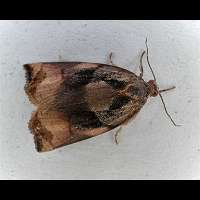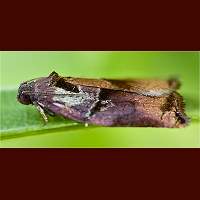Fruit-tree Tortrix (Archips podana)
The Fruit-tree Tortrix Moth is a nicely decorated brown moth. It does look like a number of other brown Tortrixes, but usually can be told apart easily by the rather large light patches in the wing a little before the tip. Like many other Tortrixes the animals are quite variable though. Females are brighter and less well marked than males. Legs and antennae are of an indistinct beige or light brown. The wingspan of the Fruit-tree Tortrix is about the same as that of many other Tortrixes: some 19 to 26 mm. A female is depicted in the top two pictures on this page. The bottom picture shows a male.
Young caterpillars are green and have a brown head and two blackish dots on the segment next to the head. Full-grown larvae are glazy brownish green and have a dark, often black head. Normally a thin black line runs over the back. The caterpillars usually stay quite small and are hardly ever over 15 mm in length. The eggs are being laid in summer and hatch quickly. The young larvae will eat some leaves but isn't harmful yet. In autumn a small web is woven on the trunks of the tree, near a leaf bud. The larva overwinters in this little web. As soon as the leaves start to unfold in spring time, the larva leaves its web, spins together the young leaves and feeds on them. In this stage it is extremely harmful to the tree, especially should the larvae appear in great numbers, which they usually do. After the attack the tree usually makes a fresh set of leaves, but the fruit remains small, if appearing at all. The caterpillar of the Fruit-tree Tortrix is very interested in fruit trees, including all cultivars. Even though it concentrates on apple, it is also interested in pears, apricots, plums etc. Even rhododendrons and roses maybe a good source of food!
The adult moths fly in one generation usually. When conditions are excellent a second generation appears from time to time. The Fruit-tree Tortrix is on the wing from June to October. Sometimes seen flying at daylight, they usually become active after dusk. It is attracted to light in very small numbers only. A common species all over Europe, including most of the British Isles, often appearing in very great numbers. Has also reached Northern America where it became a pest locally. Found in the temperate zones of Asia as well.
NB This species has been called Archips oporana in the past. That name is now used for another species, which was called Archips picaena at the time. Keep this in mind, especially when consulting books published in the 1960's and 1970's.
The Fruit-tree Tortrix Moth is a nicely decorated brown moth. It does look like a number of other brown Tortrixes, but usually can be told apart easily by the rather large light patches in the wing a little before the tip. Like many other Tortrixes the animals are quite variable though. Females are brighter and less well marked than males. Legs and antennae are of an indistinct beige or light brown. The wingspan of the Fruit-tree Tortrix is about the same as that of many other Tortrixes: some 19 to 26 mm. A female is depicted in the top two pictures on this page. The bottom picture shows a male.
Young caterpillars are green and have a brown head and two blackish dots on the segment next to the head. Full-grown larvae are glazy brownish green and have a dark, often black head. Normally a thin black line runs over the back. The caterpillars usually stay quite small and are hardly ever over 15 mm in length. The eggs are being laid in summer and hatch quickly. The young larvae will eat some leaves but isn't harmful yet. In autumn a small web is woven on the trunks of the tree, near a leaf bud. The larva overwinters in this little web. As soon as the leaves start to unfold in spring time, the larva leaves its web, spins together the young leaves and feeds on them. In this stage it is extremely harmful to the tree, especially should the larvae appear in great numbers, which they usually do. After the attack the tree usually makes a fresh set of leaves, but the fruit remains small, if appearing at all. The caterpillar of the Fruit-tree Tortrix is very interested in fruit trees, including all cultivars. Even though it concentrates on apple, it is also interested in pears, apricots, plums etc. Even rhododendrons and roses maybe a good source of food!
The adult moths fly in one generation usually. When conditions are excellent a second generation appears from time to time. The Fruit-tree Tortrix is on the wing from June to October. Sometimes seen flying at daylight, they usually become active after dusk. It is attracted to light in very small numbers only. A common species all over Europe, including most of the British Isles, often appearing in very great numbers. Has also reached Northern America where it became a pest locally. Found in the temperate zones of Asia as well.
NB This species has been called Archips oporana in the past. That name is now used for another species, which was called Archips picaena at the time. Keep this in mind, especially when consulting books published in the 1960's and 1970's.






